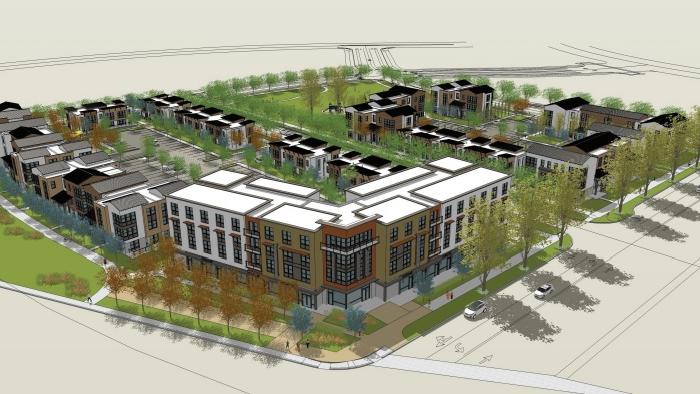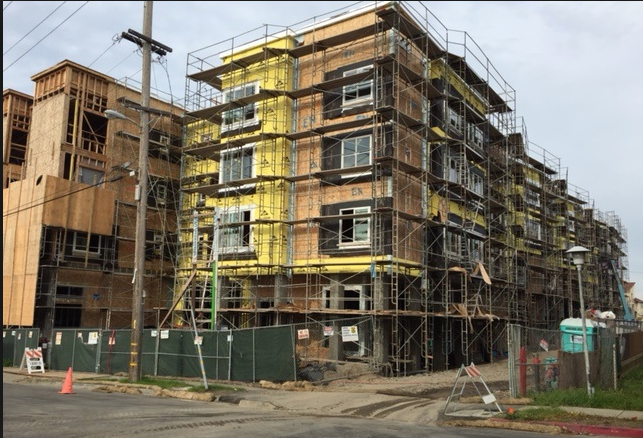
Twin Rivers redevelopment project. (Photo: SHRA)
California’s Boondoggle Archipelago
Political patronage to the well connected builders who are generous with their campaign donations
By Edward Ring, November 15, 2019 2:07 am
The Boondoggle Archipelago is defined primarily by the corrupt patronage it exemplifies.
Across California, there is a growing string of islands, exquisite gems in the urban ocean. Dredged from the pockets of taxpayers, constructed by elite artisans, these pristine islands have been created at stupefying expense. But their beauty is seductive. Spend more!
Each time an island is completed, or even proposed, glowing reports are logged across the land. So fortunate are those who shall live on these islands! So wonderful are those who shall build these islands, and care for their inhabitants! What a magnificent, marvelous thing we have done!
Or have we? From deep within the ocean a seismic wave is building, triggered by reality and propelled by common sense. Because these islands, more properly referred to as homeless shelters, supportive housing, and “low income housing,” are far too small, and far too precious, to ever, ever accommodate every castaway that needs a roof over their heads. They will never offer the required land mass to solve the problem. Instead, history shall know them as California’s Boondoggle Archipelago.
The builders of the Boondoggle Archipelago hide behind laws they won’t try to change, and behind court rulings they won’t challenge, and happily follow the rules. Happily, because the rules are rigged to ensure that the vast majority of California’s homeless and low-income families shall remain forever adrift, and so long as there are castaways, there’s money for the builders.
A short cruise across the urban ocean from north to south, visiting various typical islands in California’s Boondoggle Archipelago, should offer ample evidence that no amount of money will ever solve the problem, and therefore billions and billions of dollars, year after year, shall continue to line the pockets of the builders.
In Oakland, the “Estrella Vista” project, at a cost of $64 million, offered 87 units of affordable housing. That’s $736,000 per unit. An analysis of the project costs debunks the misleading notion that the only public money invested in these units came from Alameda County’s Measure A1, passed in 2016 to allocate $580 million to “affordable housing.”
While Alameda County’s Measure A1 Bond only contributed 3 percent to the cost of Estrella Vista, matching loans from the City of Emeryville (7.2%), the City of Oakland (3.2%), plus other federal and state sources (17.6%) constituted much of the remainder. The biggest source of funds, “LIHTC Equity,” at 42.9 percent, bears further explanation.
LIHTC stands for “Low-Income Housing Tax Credit,” and these tax credits, which can be bought, sold, and traded, represent a one-to-one reduction of a corporate tax bill. They are not a tax deduction, they are a tax credit, meaning that for any profitable corporation that pays taxes, their face value is equivalent to that same amount of cash in the bank. Who pays for tax credits? Taxpayers, since whenever taxes are avoided in one place, the resulting shortfall in tax revenues has to be covered by other taxpayers.
This is typical.
San Jose’s Measure A, approved by voters in 2016, allocated $950 million to construct affordable housing. Supposedly this beast of a bond will fund the construction of 4,800 units of affordable housing. That would come out to a supposedly reasonable average per unit cost of $198,000 (“supposedly reasonable,” because the national average cost to construct an apartment unit is only around $75,000). But not so fast. Courtesy of the County of Santa Clara Office of Supportive Housing, let’s examine this island chain:
- The “Veranda” will offer 19 units at a total development cost of $11.9 million; that’s $626,000 per unit.
- The “Villas on the Park,” 84 units for $476,000 per unit.
- The “Gateway,” 75 units for $406,000 per unit.
- The “Crossings,” 39 units for $586,000 per unit. “Quetzal Gardens,” $706,000 per unit.
- “Leigh Avenue,” $780,000 per unit.
Wading through the 15 new housing projects that have disclosed funding details, San Jose’s Measure A is part of a larger funding package – nearly all of the money coming from taxpayers – that will construct 1,357 units at a cost of $748 million. That’s $552,000 per unit.
On November 5th, San Franciscans approved Prop. A, which means their home owners will be paying principal and interest on another $600 million to build “affordable” housing. A careful review of the actual text of the ordinance indicates this money may not actually construct a single unit of new housing. Instead, the terms of this bond could be fulfilled merely by rehabilitating existing housing.
An October 7th, 2019 report in the San Jose Mercury offers a vivid example what “rehabilitation” accomplishes in the real world. The article describes how an apartment building in Antioch was converted to affordable housing, but when the renovations were completed, the tenants actually ended up paying more in monthly rent. To stay in their homes, they had to win the subsidies lottery, and rely on ongoing government assistance. Most moved out, replaced by the lucky few.
How is this helping anyone?
Rehabilitation of existing units brings us to our first island in the southern seas of California’s Boondoggle Archipelago. On October 24, Curbed LA reported that the Los Angeles City Council unanimously voted to provide an additional $24 million in homeless housing bonds to “repurpose a building on the Veterans Affairs campus in West Los Angeles for housing for veterans.” According to the article, the rehabilitated building would provide 59 units of permanent supportive housing for homeless and chronically homeless senior Veterans.
According to Ryan Thompson, writing for VeniceUpdate.com, the developer’s budget for this rehab project is $54.6 million, which equates to a per unit cost of $926,000. In his write-up, Thompson not only questions the astronomical per unit price tag, but the entire process whereby these contracts were awarded and how the designated developers were selected. It warrants close reading.
Political patronage to the well connected builders who are generous with their campaign donations.
Nonprofits exploiting their tax exempt status and hiding behind their benevolent public image while they rake in hundreds of millions.
Endlessly growing flotillas of public bureaucrats.
A lottery to anoint the lucky occupants of the few, but spectacularly expensive, island refuges.
Market rate builders setting sail for new, more competitive oceans, far, far away.
Millions of castaways remaining adrift in the urban ocean.
These are the consequences of the Boondoggle Archipelago.
Spending up to one million dollars per unit to not even create new housing, but to upgrade an existing structure, is not an outlier. These astronomical costs are common. In Venice Beach, a new structure being proposed to accommodate homeless and low income residents is budgeted, including the value of the land, at over $200 million, in order to create 140 new apartment units. That’s a cost of $1.4 million per unit.
In order to assist the homeless, in 2016, Los Angeles voters approved Proposition HHH, authorizing $1.2 billion to construct “supportive housing.” As reported by the Los Angeles Times, the total project cost, on average, for the few thousand units that will eventually get built is $550,000 each.
What’s really going on here? Are the builders who take taxpayer money to build these island paradises smooth sailors or brazen pirates? And with tens of thousands of homeless and literally millions of “low income” Californians, who do they think they’re kidding? After all, at a price tag of $500,000 each, and evidence suggests that is on the low side, it would cost $65 billion just to house California’s existing homeless. It would cost orders of magnitude more than that to build “affordable housing” for all of California’s qualifying low income families. And are these actually island paradises, or state administered wards?
The most evocative use of the word “archipelago” in the 20th century was not used in a benign context. It was “The Gulag Archipelago,” the title of a book by Alexander Solzhenitsyn that called the world’s attention to the network of prisons and labor camps that absorbed millions of Russians during the Soviet era. And during the second half of the 20th century when Solzhenitsyn was writing his book, across America we built our first Boondoggle Archipelago – housing projects. They were built, they were occupied, they demonstrably failed to alleviate poverty in the inner city, and now they’re being demolished.
What did we learn? Apparently, all we learned was spend more. Do it again.
The Boondoggle Archipelago is defined primarily by the corrupt patronage it exemplifies. But it’s worth stepping back and asking the question – are we not only wasting hundreds of billions of taxpayers money, but also condemning hundreds of thousands of Californians to dependency?
Overturn the court settlements that prevent arrests for vagrancy, and repeal Prop. 47 so users of hard drugs and petty thieves will again face jail time after repeat offenses.
If the builders and supporters of the Boondoggle Archipelago are sincere in their desire to help the homeless and the needy, they would first try the following solutions: Overturn the court settlements that prevent arrests for vagrancy, and repeal Prop. 47 so users of hard drugs and petty thieves will again face jail time after repeat offenses. Do that, and see how many “urban refugees” suddenly find shelter again with their relatives or their friends.
Then construct tent cities, taking advantage of the knowledge the U.S. Military has gained in setting up these compounds all over the world. Round up the homeless and put them into the appropriate facility – one type for substance abusers, one for petty thieves and other minor offenders, one for mentally ill, and one for families and individuals who are genuinely down on their luck. Over time, if appropriate, move these people into better shelters – but put a cap on the costs.
At the same time, to make housing affordable for low income Californians, end the environmentalist war on land development. Repeal the California Environmental Quality Act, since federal law provides ample protection. Repeal SB 375 and similar laws that have made it nearly impossible to develop open land. Start using public money to build more enabling infrastructure. Quit forcing developers to spend more money preparing permit applications and paying fees than they spend in actual construction. Then turn private investors loose to again build market housing at affordable prices. Today, developers either turn crony, or move to other states. They have no choice. The laws are rigged.
Or just stay the course on the urban seas, filling your drift nets with billions in taxpayer cash.
California’s policymakers, state and local alike, can keep throwing money into the Boondoggle Archipelago. But recognize what these facilities really are; they are housing projects, a failed model. When people are drowning, you don’t build them an island. It takes too long. It costs too much. You throw them a life preserver.
- Ringside: CA GOP Just Blew $46 Million for Nothing – Here’s How They Can Avoid Repeating That Mistake in 2026 - December 24, 2025
- Ringside: Will the Delta Pumps Operate at Capacity this Winter? - December 18, 2025
- Ringside: Will Advocates for More Water Supply Projects Find Unity? - December 11, 2025





9 thoughts on “California’s Boondoggle Archipelago”